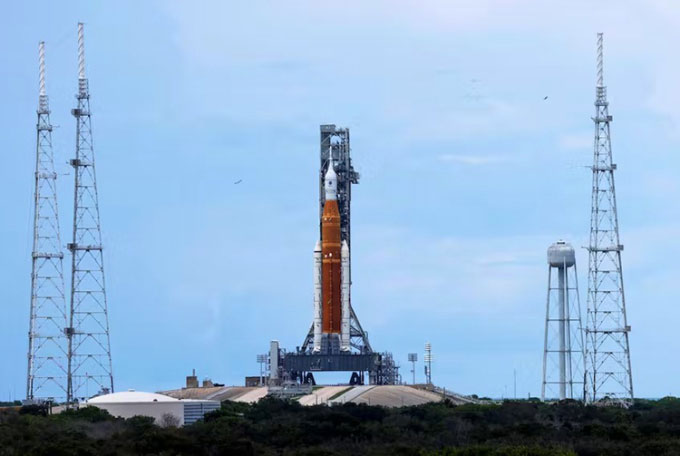The Artemis 1 mission opens a new era of interplanetary science
The Artemis 1 Moon mission failed to take off on August 29 as originally planned due to a rocket engine problem, but it will soon be restarted, possibly as soon as this week, said mission manager Mike. Sarafin of the US Space Agency (NASA) said in a press conference today.

SLS rocket and Orion spacecraft on launch pad in Florida on August 29.
If the second launch opportunity goes well, the Space Launch System (SLS) rocket will put the Orion spacecraft into lunar orbit from the Kennedy Space Center in Florida, USA, on September 2.
Artemis 1 was the first mission in the Artemis lunar exploration program, as well as the first flight of the SLS. The main goal of the mission is to demonstrate that both vehicles are ready to begin launching astronauts to the Moon as well as other deep space destinations.
This six-week test flight will carry no crew, but three high-tech crash test dummies named Zohar, Helga and Moonikin Campos. They are equipped with a wide range of sensors to measure everything from vibrations to radiation.
In addition to the dummies, the Orion's interior contains a variety of scientific payloads such as seeds, algae, fungi and yeast that are carefully packaged to study how space radiation affects cell life based on DNA. . The ultimate goal is to help humans colonize extraterrestrial planets like Mars.
Through industry partnerships, the mission also includes a laptop running both Alexa and Cisco Webex video conferencing software, to see how well it communicates with the ground station in Houston. , Texas.
Artemis 1 also deployed several shoebox-sized satellites - called CubeSat - to study the Moon's surface and analyze its composition.
The highest-priority test, however, is the new heat shield on Orion to protect the spacecraft as it re-enters the atmosphere at a record high speed, faster than the Space Shuttle. This can cause the ship to heat up to 2,760 degrees Celsius.
"This is no longer the Apollo generation, it's the Artemis generation. We will go back to the Moon but will learn and develop new technologies, because the end goal is to go to Mars." NASA Administrator Bill Nelson emphasized.

Simulation of Orion spacecraft flying in lunar orbit during the Artemis 1 mission.
Last year, NASA landed a truck-sized rover on Mars, deployed a mini-helicopter in the planet's thin atmosphere and recently received the first images from the James Space Telescope. Webb.
This reflects the technological and scientific momentum Artemis wants to exploit, following the failure of NASA's Constellation crewed space flight program between 2005 and 2009. Former US President Barack Obama kicked it off. The Artemis program in 2010, set 2033 as the target year for humans to conquer Mars.
There's a lot to learn about the Moon. Thomas Zurbuchen, head of NASA's science directorate, recalls a favorite photograph of Buzz Aldrin when he performed a science experiment on the surface of the Moon in 1969: deploying a piece of aluminum foil to collect The solar wind is shining on the surface of the Moon at a speed of 400 km/s. It's a perfect example of an astronaut as a scientist.
An important part of Artemis 1's mission is to understand what natural resources, such as water or minerals, might be on the Moon. "Of course, those resources have to be really unexpected compared to the picture of the Moon we've had in the past," Zurbuchen said.
For example, water has been detected on the Moon, and two of the CubeSats (small satellites) on board will map that water in different ways: one using neutrons and the other using infrared spectroscopy.
Another CubeSat, called NEA Scout, will deploy 86-square-foot "solar sails" over two years, towards a near-Earth asteroid, and then photograph and analyze its shape and mass. volume, rotational characteristics, debris, dust and surface appearance.
Artemis 1 is the first mission in the Artemis lunar exploration program since the last Apollo mission in 1972. After nearly 50 years, NASA has established a program to send humans to land in uncharted territory on Earth. Moon.
According to the roadmap, after the successful launch of Artemis 1, this unmanned mission will test every new component that makes future deep space exploration possible. The astronauts will then make the journey in 2024 and 2025 during the Artemis II and Artemis III missions.
- The Artemis space mission comes with a hefty price tag
- A close up of a new NASA astronaut suit
- Advertise on Mars
- NASA's Artemis vessel has been completed, ready to take the first woman to the Moon
- Where NASA is about to send humans back to the Moon
- Two twin satellites Artemis in the moon's orbit
- Temple of Goddess Artémis
- NASA proposes the 'Artemis Treaty': Code of Conduct for countries exploring the universe
- Voyager's controversy
- The temple of the goddess Artemis was discovered in Greece's second largest island
- What does NASA send yeast to space for?
- NASA is about to send iPads to the Moon's orbit
 Van Allen's belt and evidence that the Apollo 11 mission to the Moon was myth
Van Allen's belt and evidence that the Apollo 11 mission to the Moon was myth The levels of civilization in the universe (Kardashev scale)
The levels of civilization in the universe (Kardashev scale) Today Mars, the sun and the Earth are aligned
Today Mars, the sun and the Earth are aligned The Amazon owner announced a secret plan to build a space base for thousands of people
The Amazon owner announced a secret plan to build a space base for thousands of people